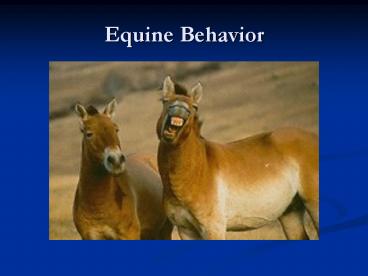Equine Behavior - PowerPoint PPT Presentation
1 / 32
Title:
Equine Behavior
Description:
Detect sounds. Determine location of sound. To provide sensory information ... We or another animal cause them to move when they prefer not to ... – PowerPoint PPT presentation
Number of Views:1368
Avg rating:3.0/5.0
Title: Equine Behavior
1
Equine Behavior
2
What Affects Behavior?
- Environment
- Experiences
- Diet
- Exercise
- Stress
- Genetics
- Gender
- Type
- Breed
- Family group
3
- Smell
- Identify other horses
- Mating
- Locate water, feed
- Vomeronasal organ
- Pheromones
- Ears Hearing
- Detect sounds
- Determine location of sound
- To provide sensory information
- Hear in range 14 Hz to 25 kHz (humans 20 Hz to 20
kHz) - Auricle 180o rotation
- Ear position generally relates to visual attention
4
- Touch
- Responsive to pain, pressure, cold and heat
- Sensitive areas
- Eyes, ears and nose
- Withers, ribs, flanks and legs
- Suffers fatigue
5
VISION
- Primary detector of danger
- Acute ability to detect movement
- Monocular Binocular vision
- Monocular field of vision 215o for each eye
- Binocular field of vision 60o-70o
- Often raise head to observe close objects
- Lower head to observe faraway objects
Monocular field Up to 215o
Binocular field 60-70o
Marginal zone
Monocular field
6
Visual Signs
- Ears
- Tail
- Mouth lips
- Eyes
- Nostrils
7
(No Transcript)
8
Horse BehaviorSocial Organization
- Harem groups Domestic horses, Przewalski horse
some zebra
- Territorial breeders-Donkeys some zebras
9
Social Organization
- Harem
- Family
- Mares
- Stallion
- Bachelor Group
10
Ten Natural Survival Traits
- Depends on flight as its primary means of
survival - One of the most perceptive of all domestic
animals - Very fast response time
- Can be desensitized from frightening stimuli
- Horses forgive, but do not forget
11
Ten Natural Survival Traits
- Horses categorize
- A) something not to fear, so ignore or explore
- B) Something to fear, so flee
- Horses are easily dominated
- Horses exert dominance by controlling the
movement of their peers. Horse accept dominance
when - We or another animal cause them to move when they
prefer not to - We or another animal inhibit movement when they
want to flee
12
Ten Natural Survival Traits
- The body language of a horse is unique to the
equine species - Horse is a precocial species (newborn foals are
neurologically mature at birth)
13
Types of Horse Behavior
- Ingestive behavior
- Eliminative behavior
- Epimeletic behavior -Care-giving care-seeking
behavior
14
Types of Horse Behavior
- Sexual
- Polygamous
- One offspring
- Seasonal Breeders
- Fetal behavior
- Parturient behavior
15
Horse Behavior
- Self-care behavior
- Homeostatic influences
- Grooming
- Rest
- Awake 80
- Drowsiness 8
- Sleep 12
- Autogroom
- Mutual Groom
16
Types of Horse BehaviorInvestigative Behavior
- Play behavior
- Exploratory behavior
17
Types of Horse Behavior
- Allelomimetic Behavior
- Mimicry
18
Types of Horse BehaviorAgonistic Behavior
19
Types of Horse Behavior
- Dominance/Submission (Social Order)
20
Horse Behavior
- Spacing
- Individual distance
- Group distance
- Social distance
- Flight distance
- Home range
- Territorial
21
Activity
- Diurnal
- Travel up to 16 km/d (10 mile/d)
- Home range, can be up to 1000 ha.(2500 acres)
- Range 0.8-303 sq. km (0.5-188 sq. mile)
22
Average Time Budgets For Horses
23
Behavioral Considerations in Equine Handling
- HERD INSTINCT
- HOMING INSTINCT
- FLIGHT
- DOMINANCE HEIREACHY
- TERRITORIAL BEHAVIOR
- SELF-DEFENSE
- HABIT
24
Stress
- Good Stress The stressful condition in which
the horse can find a solution that will relieve
the stress
- Harmful Stress A stressful condition in which
there is no possible solution or escape.
25
Responses To Harmful Stress
- Habituate
- Develop abnormal behavior
- Permanent fear memory
26
Equine Stereotypes
- Oral
- Cribbing
- Tongue movements
- Lip movements
27
Equine Stereotypes
- Locomotion
- Head movements (bobbing, tossing, shaking,
swinging, nodding) - Throat rubbing
- Pacing
- Weaving
- Fence or stall walking
28
Equine Stereotypes
- Locomotion
- Circling
- Stomping
- Kicking
- Pawing
- Digging
- Tail rubbing
29
Equine Stereotypes
- Self-Mutilation
- Self-biting (flank, chest, shoulder)
- Wall-kicking
- Lunging into objects
30
EQUINE VICES
- AGGRESSIVE VICES
- Biting
- Charging
- Crowding
- Rearing
- Kicking
- Striking
- Fighting
31
EQUINE VICES
- METABOLIC VICES
- Coprophagy or dirt eating
- Cribbing
- Mane and tail chewing
- Wood chewing
32
(No Transcript)






























